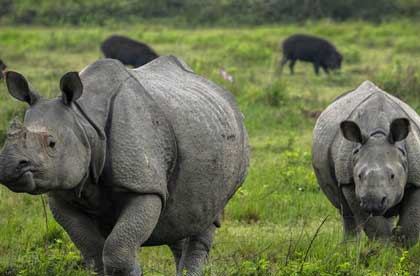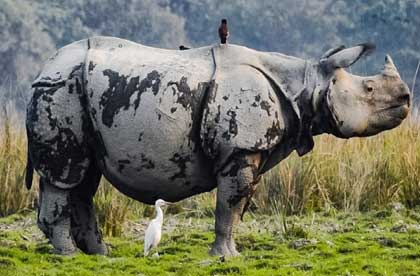One of the most sought-after Wildlife destinations in India, the Kaziranga National Park is the only natural habitat in the world with such a large number of one-horned Rhinoceros. Boasting of being the home to a whopping more than two thousand of the one-horned Rhinos, the Kaziranga Forest is the best place to get the unhindered sighting of the various large wild animals such as tigers, leopards, Indian wild elephants, Rhinoceros, wild buffalo and wild boars along with many other small wild animals such as Hoolock Gibbons, spotted deer, swamp deer, Goar, Sambhar and many other species.
Declared as the World Heritage site by the UNESCO, this amazing wildlife-rich forest is located in the Assam, a northeastern state of India. The landscape that spreads along the River Brahmaputra on the north side and touching the Karbi Anglong hills on the south constitutes a dense greenery rich forest belt to provide shelter to a large number of wildlife species. The location of the park is well connected through the state roadways and National Highway. With the railway station and airport located not so far, the park can easily be accessed through any part of the country or abroad.
The park remains open from November to April months of every year for the wildlife lovers to visit and explore the amazing wildlife that resides in the park by using the safari services organized by the forest officials. Though the forest of Kaziranga can be accessed only through the roadways, but by using the railways and airways, one can reach the nearest point to the park from where the park can be reached using the roadway transport. Below is the detailed information to reach Kaziranga


Introduction – Rhinoceros -
If we compare with the size the Indian rhino is equal to that of the white rhino found in Africa. An adult male fully grown are bigger than female in the wild – weighing from 2,200 kg to 3,000 kg. Basically Indian Rhino is 1.7 to meter tall and can be up to 4 meter long.
Interestingly, An Indian Rhino is a single horn found in both males and females but not on newly born child. The horn, like human fingernails, is pure keratin and starts to show after about 6 years. In most of the adults the length of the horn develops up to 25 centimeters but in some exceptional cases it has been recorded up to 57 centimeters in length. Horn color is naturally black. The skin of the Rhinoceros has thick silver-brown cover which turns pinkish near large skin folds that covers the body properly. Generally male develops thick neck folds. Rhino upper leg potion and shoulders are covered in verruca-like bumps. They have a very little hair in their body. In captivity, four are known to have lived over 40 years, the oldest living to be 47.
COMMON NAME : Indian Rhinoceros
SCIENTIFIC NAME : Rhinoceros Unicornis
TYPE : Mammals
DIET : Herbivore
AVERAGE LIFE SPAN IN THE WILD : 40 years
SIZE : Length: 12.5 feet; height at shoulder: up to 6 feet
WEIGHT : 2.2 tons
Behavior And Diet
Like other animals Rhinos have sharp hearing and a keen sense of smell. Their natural habitat is tall grasslands riverine forests but due habitat exploitation by men they are forced to live in cultivated land. The great Indian Rhino can move very fast when aroused. They prefer to live all alone with the exception of mothers and calves and breeding pairs. The male home ranges 2-8 square kilometers in size.
Dominant males tolerate males passing through their territory except when they are in mating season, when dangerous fights break out. They are active at night and early morning. They spend the middle of the day wallowing in lakes, rivers, ponds, and puddles to cool down. They are extremely good swimmers.
Indian Rhino have very few enemies in Jugle except for tigers. Big cat sometimes kill unguarded calves, but adult rhinos are less vulnerable due to their size. Human being is the biggest threat to Rhino as they hunt primarily for sport or for the use of its horns.
The great Indian Rhino is basically grazer that travels established tunnel like way through it tall-grass habitat. Basically they are known to eat leaves, branches of shrubs and trees fruits and submerged and floating aquatic plants.
Rhino At Kaziranga National Park
A census in India's Kaziranga National Park has counted 2,413 one-horned rhinos - up 12 from 2015. The UNESCO World Heritage Site, in Assam state, is home to two-thirds of the world's population of the species. The census program is conducted by state forest department at every three years of interval.